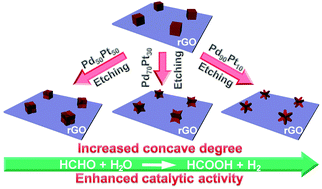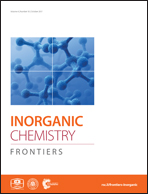Chemical etching of graphene-supported PdPt alloy nanocubes into concave nanostructures for enhanced catalytic hydrogen production from alkaline formaldehyde aqueous solution†
Abstract
Catalytic hydrogen production from alkaline formaldehyde aqueous solution is a promising route to supply hydrogen on a large scale for practical applications. Producing highly efficient and low-cost catalysts is the main challenge for future development of the hydrogen economy through this route. In this paper, PdPt concave nanostructures supported on reduced graphene oxide (rGO) nanosheets are facilely obtained through chemical etching of PdPt nanocubes with nitric acid. By adjusting the Pd : Pt ratio of the nanocubes, PdPt alloy nanostructures with different degrees of concavity are obtained as a result of different etching kinetics. The as-obtained rGO supported concave nanostructures serve as highly efficient catalysts in H2 production from alkaline formaldehyde aqueous solution. On one hand, through adjusting the Pd : Pt molar ratio, a synergistic effect between Pd and Pt is realized to enhance the catalytic activity. On the other hand, the surface concave structures of the PdPt nanocrystals offer a high density of low-coordinated atoms, serving as highly active sites for the catalytic H2 production reaction. Furthermore, rGO nanosheets as a support are found to prevent the aggregation of metal nanocrystals and to improve the catalytic activity and stability. Based on the surface composition and structure optimization, the as-obtained rGO supported Pd90Pt10 octapods achieved the highest average hydrogen production rate of 0.85 mmol gcat−1 min−1, about 9 times higher than that of pure Pt nanoparticles. Also, the advantages of the rGO-Pd90Pt10 COPs are highlighted by the minimal Pt content and excellent catalytic stability during successive cyclic processes. This work not only highlights the shape-controlled synthesis of concave metal nanocrystals through adjustment of the etching kinetics, but also underlines the importance of the collaborative design of the surface structure and composition as well as the catalyst support in realizing highly efficient hydrogen generation.



 Please wait while we load your content...
Please wait while we load your content...